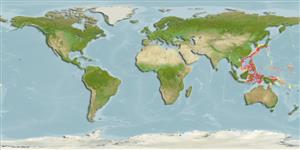Actinopterygii (ray-finned fishes) >
Stomiiformes (Lightfishes and dragonfishes) >
Sternoptychidae (Marine hatchetfishes) > Sternoptychinae
Etymology: Polyipnus: Greek, poly = a lot of + Greek, ipnos = lanterns.
Environment / Climate / Range
Ecology
Marine; benthopelagic; depth range 154 - 380 m (Ref. 26382), usually 220 - 380 m (Ref. 26382). Deep-water, preferred ?
Western Pacific: Suruga Bay (Japan), the East China Sea and off the Philippines in the South China and Sulu seas.
Size / Weight / Age
Maturity: Lm ? range ? - ? cm
Max length : 6.0 cm SL male/unsexed; (Ref. 559)
Short description
Morphology | Morphometrics
Specimens have been collected above 150 m in Suruga Bay, Japan (Ref. 26382).
Life cycle and mating behavior
Maturity | Reproduction | Spawning | Eggs | Fecundity | Larvae
Harold, A.S., 1994. A taxonomic revision of the sternoptychid genus Polyipnus (Teleostei: Stomiiformes) with an analysis of phylogenetic relationships. Bull. Mar. Sci. 54(2):428-534. (Ref. 26382)
IUCN Red List Status (Ref. 115185)
CITES (Ref. 94142)
Not Evaluated
Threat to humans
Harmless
Human uses
More information
Common namesSynonymsMetabolismPredatorsEcotoxicologyReproductionMaturitySpawningFecundityEggsEgg development
Age/SizeGrowthLength-weightLength-lengthLength-frequenciesMorphometricsMorphologyLarvaeLarval dynamicsRecruitmentAbundance
ReferencesAquacultureAquaculture profileStrainsGeneticsAllele frequenciesHeritabilityDiseasesProcessingMass conversion
Tools
Special reports
Download XML
Internet sources
